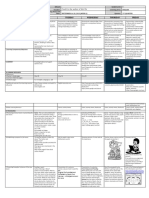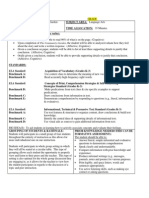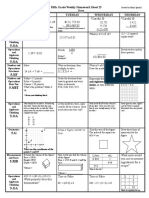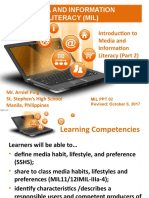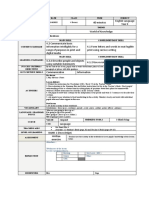Standards:: V Name - Date - Period
Uploaded by
api-328344919Standards:: V Name - Date - Period
Uploaded by
api-328344919v
Name______________________________ Date___________________ Period _____________
Module 1:
Start Date: August 8, 2016
Completion Date: September 16, 2016
Total Days: 39
(Students will be expected to complete activities during class and at home for 30 minutes each night.)
Standards:
ELAGSE5RI1: Quote accurately from a text when
K-5 EU: The student will understand that peoples ideas and
S5P1. Students will verify that an object is the sum of its parts. b.
explaining what the text says explicitly and when
feelings influence their decisions
Investigate how common items have parts that are too small to be
drawing inferences from the text.
ELAGSE5RI2: Determine two or more main ideas of
a text and explain how they are supported by key
K-5 EU: The student will understand that conflict causes
change.
seen without magnification.
S5L3. Students will diagram and label parts of various cells (plant,
animal, single-celled, multi-celled). a. Use magnifiers such as
details; summarize the text.
K-5 EU: The student will understand that what people, groups,
and institutions say and do can help or harm others whether they
microscopes or hand lenses to observe cells and their structure. b.
ELAGSE5RI3: Explain the relationships or
mean to or not
Identify parts of a plant cell (membrane, wall, cytoplasm, nucleus,
interactions between two or more individuals,
events, ideas, or concepts in a historical, scientific,
or technical text based on specific information in
the text.
ELAGSE5RI4: Determine the meaning of general
academic and domain-specific words and phrases in
a text relevant to a grade 5 topic or subject area.
ELAGSE5RI5: Compare and contrast the overall
K-5 EU: The student will understand that where people live
matters.
K-5 EU: The student will understand that moving to new places
changes the people, land, and culture of the new place, as well as
the place that was left.
K-5 EU: The student will understand that because people cannot
have everything they want, they have to make choices.
chloroplasts) and of an animal cell (membrane, cytoplasm, and
nucleus) and determine the function of the parts. c. Explain how
cells in multi-celled organisms are similar and different in structure
and function to single-celled organisms.
S5L4. Students will relate how microorganisms benefit or harm
larger organisms. a. Identify beneficial microorganisms and explain
why they are beneficial.
structure (e.g., chronology, comparison,
b. Identify harmful microorganisms and explain why they are
cause/effect, problem/solution) of events, ideas,
harmful
concepts, or information in two or more texts
ELAGSE5RI6: Analyze multiple accounts of the
same event or topic, noting important similarities
and differences in the point of view they represent.
ELAGSE5W2: Write informative/explanatory texts
to examine a topic and convey ideas and information
clearly.
a. Introduce a topic clearly, provide a general
observation and focus, and group related
information logically; include formatting (e.g.,
headings), illustrations, and multimedia when useful
to aiding comprehension.
b. Develop the topic with facts, definitions,
concrete details, quotations, or other information
and examples related to the topic.
c. Link ideas within and across categories of
information using words, phrases, and clauses
d. Use precise language and domain-specific
vocabulary to inform about or explain the topic.
e. Provide a concluding statement or section
related to the information or explanation presented
ELAGSE5L2: Demonstrate command of the
conventions of Standard English capitalization,
punctuation, and spelling when writing.
a. Use punctuation to separate items in a series.*
b. Use a comma to separate an introductory
element from the rest of the sentence. c. Use a
comma to set off the words yes and no (e.g., Yes,
thank you), to set off a tag question from the rest
of the sentence (e.g., Its true, isnt it?), and to
indicate direct address (e.g., Is that you, Steve?).
d. Use underlining, quotation marks, or italics to
indicate titles of works.
e. Spell grade-appropriate words correctly,
consulting references as needed.
Key Vocabulary:
Reading & Language Arts
Social Studies
Science
print source, digital source historical , contemporary,
beliefs and ideals; conflict and change; individuals, groups,
Cell, cell membrane, cell wall, cytoplasm, nucleus, chloroplasts, structure,
firsthand account , secondhand account , primary
institutions; location; movement/migration; production,
function, magnifying, microscope, single-celled, multi- celled, microorganism,
source , secondary source comparison ,contrast ,
distribution, consumption; scarcity; and technological
harmful, beneficial, disease, bacteria, virus, protists, protozoa, germs,
structure , chronology , perspective, text features ,
innovations
microbe
context , morphology
I can statement/ Essential Question
How does word choice impact the
overall meaning of the text?
How does the authors use of
structure affect the meaning of the text?
How does the authors point of view
and purpose shape and direct the text?
Why do readers read?
How do readers construct meaning?
How does word choice impact the
overall meaning of the text?
. How does the authors use of
structure affect the meaning of the text?
How does the authors point of view
and purpose shape and direct the text?
How does analyzing diverse media
How do the beliefs and ideals of a
What do we see when we take a closer look?
How are the structures of the animal cell and plant cell
society influence the social, political, and economic
similar?
How are the structures of the animal cell and plant cell
decisions I make.
How does conflict lead to change within
different?
How can you differentiate a single-celled organism from
societies? How do we resolve conflict within our
a multi-celled organism?
If you cant see them, can they harm you?
How are microorganisms controlled?
Where did all of those little things come from?
Why arent microorganisms in tap water?
decisions of that society?
How do my own beliefs influence the
school and classroom?
How can conflict lead to positive
changes?
How can conflict lead to negative
changes?
How does location affect societys
economy, culture, and development?
help us to build our own knowledge?
How does the use of evidence impact
the authors claim?
How does analyzing more than one
text help us to interpret the authors intent and
build our knowledge?
Unit Performances:
Activity Title
Est.
Quiz or
Time
Practice Work
*AR Quiz 4
4cp
Quiz
Text Evidence : Choose 2 Passages and Answer Question (RI 1)
2 cp
PW
* What If...Scenarios??? (RI1)
2 cp
PW
A (*) is an assignment that MUST be completed
Points
Total
Received
Points
Teacher Initial
*Newsela Main Idea Graphic Organizer (RI2)
2cp
PW
*Name That Text Structure (RI5)
2cp
PW
*Wanted Poster
cp
PW
*Microorganism Research/ Information Brochure
3 cp
PW
*Concepts of Social Studies & Effective Citizenship Grid
1 cp
PW
Movement & Migration
2 cp
PW
*Citizenship WebQuest (Due August 25)
1 cp.
Quiz
Memoirs of a Goldfish: Cause and Effect Book
2 cp
PW
Performance Task
Activity Title
Est.
Time
Group/
Independent
*Celling Cereal Project: (Home assignment)
2hrs
Independent
All You Cell (Home assignment)
2hrs.
Independent
Technological Innovation: Writing
1hrs
Both
Technological Innovation School belief
1hrs
Both
*Bill of Right Visual Presentation:
2 hr
Both
5 hrs
Independent
*The World According to Humphrey Diorama (Due on
September 15)
Points
Total
Received
Points
Teacher Initial
You might also like
- The Senses. Comprehensive Reference (NeuroscienNo ratings yetThe Senses. Comprehensive Reference (Neuroscien4,112 pages
- EDU 512: Writing Lesson Plan: Preliminary Information100% (1)EDU 512: Writing Lesson Plan: Preliminary Information10 pages
- 3 - Condon Maiorano Modified 03.17.2014 - 03.21.2014No ratings yet3 - Condon Maiorano Modified 03.17.2014 - 03.21.201428 pages
- Grade 5 Literacy in Social Studies: The United States, Canada and Latin AmericaNo ratings yetGrade 5 Literacy in Social Studies: The United States, Canada and Latin America9 pages
- English6 - Q2 - DLP - Week 3 - Identifying The Purpose and The Structural and Language Features of Various Types of InformationalFactual Text100% (4)English6 - Q2 - DLP - Week 3 - Identifying The Purpose and The Structural and Language Features of Various Types of InformationalFactual Text5 pages
- Grade 5 Literacy in Social Studies: The United States, Canada and Latin AmericaNo ratings yetGrade 5 Literacy in Social Studies: The United States, Canada and Latin America9 pages
- 6th Grade Social Studies Curriculum MapNo ratings yet6th Grade Social Studies Curriculum Map14 pages
- 2 As Scientific Experimentalmath TM New 2018100% (2)2 As Scientific Experimentalmath TM New 20185 pages
- Informational Text Structures Reading WritingcorrectoneNo ratings yetInformational Text Structures Reading Writingcorrectone12 pages
- 1st Lesson Plan... The Community Garden..No ratings yet1st Lesson Plan... The Community Garden..6 pages
- GRADES 1 To 12 Daily Lesson Log Monday Tuesday Wednesday Thursday FridayNo ratings yetGRADES 1 To 12 Daily Lesson Log Monday Tuesday Wednesday Thursday Friday10 pages
- 12th Grade Economics Curriculum Guide 2015No ratings yet12th Grade Economics Curriculum Guide 201543 pages
- Social Studies Family Tree Lesson Set Unit 3No ratings yetSocial Studies Family Tree Lesson Set Unit 329 pages
- Presentation of NAVIO Show Students The ReadingNo ratings yetPresentation of NAVIO Show Students The Reading14 pages
- Typical Course of Study: Grade 7: Language ArtsNo ratings yetTypical Course of Study: Grade 7: Language Arts8 pages
- Grade 10 March 25 Mocks Syllabus Organized (2)No ratings yetGrade 10 March 25 Mocks Syllabus Organized (2)16 pages
- Social Studies Unit-Families Now and Long Ago UnitNo ratings yetSocial Studies Unit-Families Now and Long Ago Unit20 pages
- Typical Course of Study: Grade 8: Language ArtsNo ratings yetTypical Course of Study: Grade 8: Language Arts8 pages
- eng6-secondary-source-lesson-plan_090858No ratings yeteng6-secondary-source-lesson-plan_0908586 pages
- Ued 496 Isabella Szczur Student Teaching Rationale and Reflection Paper 3No ratings yetUed 496 Isabella Szczur Student Teaching Rationale and Reflection Paper 37 pages
- Nina Musurlian - Edu443 - Designing Strategy-Based Comprehension InstructionNo ratings yetNina Musurlian - Edu443 - Designing Strategy-Based Comprehension Instruction10 pages
- Personal Narrative Graphic Organizer SnapshotNo ratings yetPersonal Narrative Graphic Organizer Snapshot1 page
- End Your Year With Your Students Taking Over The Class!: I'm The Teacher!No ratings yetEnd Your Year With Your Students Taking Over The Class!: I'm The Teacher!7 pages
- 3 13 17weekly Homework Sheet Week 25 - 5th Grade - CcssNo ratings yet3 13 17weekly Homework Sheet Week 25 - 5th Grade - Ccss2 pages
- 3 6 17science-Social Studies Weekly Homework Sheet Week 22 - 5th GradeNo ratings yet3 6 17science-Social Studies Weekly Homework Sheet Week 22 - 5th Grade2 pages
- 3 6 17science-Social Studies Weekly Homework Sheet Week 22 - 5th GradeNo ratings yet3 6 17science-Social Studies Weekly Homework Sheet Week 22 - 5th Grade2 pages
- 3 6 17weekly Homework Sheet Week 23 - 5th Grade - CcssNo ratings yet3 6 17weekly Homework Sheet Week 23 - 5th Grade - Ccss3 pages
- 2 20 17weekly Homework Sheet Week 19 - 5th Grade - CcssNo ratings yet2 20 17weekly Homework Sheet Week 19 - 5th Grade - Ccss3 pages
- 2 20 17science-Social Studies Weekly Homework Sheet Week 27 - 5th GradeNo ratings yet2 20 17science-Social Studies Weekly Homework Sheet Week 27 - 5th Grade2 pages
- Physical and Chemical Changes Webquest RevNo ratings yetPhysical and Chemical Changes Webquest Rev1 page
- Constructive & Destructive Forces On LandformsNo ratings yetConstructive & Destructive Forces On Landforms16 pages
- Media and Information Literacy (Mil) Media and Information Literacy (Mil)No ratings yetMedia and Information Literacy (Mil) Media and Information Literacy (Mil)34 pages
- Effective Communication and Miscommunication67% (3)Effective Communication and Miscommunication7 pages
- Towards A Sustainable Information Society: Deconstructing WSIS100% (2)Towards A Sustainable Information Society: Deconstructing WSIS221 pages
- Emergency Registration in Refugee OperationsNo ratings yetEmergency Registration in Refugee Operations19 pages
- Course Outline-HLWI230-1-Jan-Jun2024-V2-07022024No ratings yetCourse Outline-HLWI230-1-Jan-Jun2024-V2-07022024208 pages
- 2 World Literature-Scope and Sequence Fy13-14No ratings yet2 World Literature-Scope and Sequence Fy13-145 pages
- Office Administration: Topic: Records Management II Lecturer: DateNo ratings yetOffice Administration: Topic: Records Management II Lecturer: Date40 pages
- Bloom's Taxonomy (Revised Edition) Lesson PlanNo ratings yetBloom's Taxonomy (Revised Edition) Lesson Plan4 pages
- Gold-YOLO: Efficient Object Detector Via Gather-and-Distribute MechanismNo ratings yetGold-YOLO: Efficient Object Detector Via Gather-and-Distribute Mechanism19 pages
- QEd-Text-Map-and-VIPERS-Progression.298908239No ratings yetQEd-Text-Map-and-VIPERS-Progression.29890823916 pages
- Review of Related Literature Management Information SystemNo ratings yetReview of Related Literature Management Information System3 pages






















